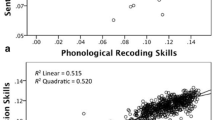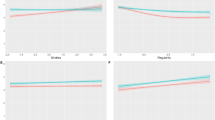Abstract
A phonological confusion task was employed to explore whether or not beginning readers of Chinese activate phonological codes while reading Chinese characters. Twenty first graders and twenty third graders read phonologically similar and dissimilar character strings. Following the presentation of each string, they were required to identify the characters from among a set of recognition items. Three major findings indicated that subjects used phonological codes while reading Chinese characters: (1) Subjects recognized fewer phonologically similar characters than phonologically dissimilar ones; (2) The phonological confusion effect varied with degree of phonological similarity among the characters read. Characters having the same rhyme and same tone (SRST) were recognized less accurately than characters of the same rhyme but different tones (SRDT), which in turn were recognized less accurately than characters of different rhymes and different tones (DRDT); (3) Silent reading and oral reading resulted in similar patterns of phonological confusion, indicating that similar codes were activated during the two reading conditions.
Similar content being viewed by others
References
Aaronson, D. & Ferres, S. (1983). A model for coding lexical categories during reading,Journal of Experimental Psychology: Human Perception and Performance 9: 700–725.
Allport, D. A. (1979). Word recognition in reading: A tutorial review. In: P. A. Kolers, H. Bouma & M. Wrolstad (eds.),Processing of visible language (pp. 227–257). New York: Plenum Press.
Baddeley, A. D. (1979). Working memory and reading. In: P. A. Kolers, H. Bouma & M. Wrolstad (eds.),Processing of visible language (pp. 355–370). New York: Plenum Press.
Baddeley, A. D. (1986). Working memory. Oxford: Clarendon Press.
Baddeley, A. D. & Hitch, G. T. (1974). Working memory. In: G. H. Bower (eds.),The psychology of learning and motivation, Vol. 18 (pp. 47–89). New York: Academic Press.
Baddeley, A. D. & Lewis, V. J. (1981). Inner active processes in reading: The inner ear, inner voice, and inner eye. In: A. M. Lesgold & C. A. Perfetti (eds.),Interactive processes in reading (pp. 107–129). Hillsdale, NJ: Erlbaum.
Baddeley, A. D., Eldridge, M. & Lewis, V. (1981). The role of subvocalization in reading,Quarterly Journal of Experimental Psychology 33: 439–454.
Baron, J. (1973). Phonemic stage not necessary for reading,Quarterly Journal of Experimental Psychology 25: 241–246.
Besner, D., Davies, J. & Daniels, S. (1981). Reading for meaning: The effects of concurrent articulation,Quarterly Journal of Experimental Psychology 33: 415–437.
Cheng, C. M. & Shih, S. I. (1988). The nature of lexical access in Chinese: Evidence from experiments on visual and phonological priming in lexical judgment. In: I. M. Liu, H. C. Chen & M. J. Chen (eds.),Cognitive aspects of the Chinese language (pp. 1–14). Hong Kong: Asian Research Service.
Coltheart, M. (1978). Lexical access in simple reading tasks. In: G. Underwood (ed.),Strategies for information processing (pp. 151–216). London: Academic Press.
Coltheart, V., Avons, S. E. & Trollope, J. (1990). Articulatory suppression and phonological codes in reading for meaning,Quarterly Journal of Experimental Psychology 42: 375–399.
Coltheart, V., Laxon, V., Rickard, M. & Elton, C. (1988). Phonological recoding in reading for meaning by adults and children,Journal of Experimental Psychology: Learning, Memory, and Cognition 14: 387–397.
Conrad, R. (1964). Acoustic confusion in immediate memory,British Journal of Psychology 55: 75–84.
Daneman, M. (1987). Reading and working memory., In: J. R. Beech & A. M. Colley (eds.),Cognitive approaches to reading (pp. 57–86). New York: Wiley.
Daneman, M. & Stainton, M. (1991). Phonological recoding in silent reading,Journal of Experimental Psychology: Learning, Memory, and Cognition 17: 618–632.
Frost, R. & Bentin, S. (1992). Phonological and semantic ambiguity: Evidence from semantic priming at different SOAs,Journal of Experimental Psychology: Learning, Memory, and Cognition 18: 58–68.
Frost, R. & Katz, L. (1989). Orthographic depth and the interaction of visual and auditory processing in word recognition,Memory and Cognition 17: 302–310.
Frost, R., Katz, L. & Bentin, S. (1987). Strategies for visual word recognition and orthographical depth: A multilingual comparison,Journal of Experimental Psychology: Human Perception and Performance 13: 104–114.
Hanson, V. L. & Fowler, C. A. (1987). Phonological coding in word reading: Evidence from hearing and deaf readers,Memory and Cognition 15: 199–207.
Huey, E. B. (1968).The psychology and pedagogy of reading. Cambridge, MA: MIT Press (Originally published, 1908).
Hung, D. L. & Tzeng, O. J. L. (1981). Orthographic variation and visual information processing,Psychological Bulletin 90: 377–414.
Kirk, R. E. (1968).Experimental design: Procedures for the behavioral sciences. Monterey, CA: Brooks/Cole.
Kleiman, G. M. (1975). Speech recoding in reading,Journal of Verbal Learning and Verbal Behavior 14: 304–316.
Leong, C. K. (1986). What does accessing a morphemic script tell us about reading and reading disorders in an alphabetic script?,Annals of Dyslexia 36: 82–102.
Lukatela, G. & Turvey, M. T. (1990). Phonemic similarity effects and prelexical phonology,Memory and Cognition 18: 128–152.
McCusker, L. X., Hillinger, M. L. & Bias, R. G. (1981). Phonological recoding and reading,Psychological Bulletin 89: 217–245.
McCutchen, D. & Perfetti, C. A. (1982). The visual tongue-twister effect: Phonological activation in silent reading,Journal of Verbal Learning and Verbal Behavior 21: 679–687.
McCutchen, D., Bell, L. C., France, I. M. & Perfetti, C. A. (1991). Phoneme-specific interference in reading: The visual tongue-twister effect revisited,Reading Research Quarterly 26: 87–103.
Morais, J. (1991). Constraints on the development of phonemic awareness. In: S. A. Brady & D. P. Shankweiler (eds.),Phonological processes in literacy: A tribute to Isabelle Y. Liberman (pp. 5–27). Hillsdale, NJ: Lawrence Erlbaum Associates.
Morais, J., Gary, L., Alegria, J. & Bertelson, P. (1979). Does awareness of speech as a sequence of phones arise spontaneously?,Cognition 7: 323–331.
Morton, J. & Sasanuma, S. (1984). Lexical access in Japanese. In: L. Henderson (ed.),Orthographies and reading (pp. 25–42). Hillsdale, NJ: Erlbaum.
Paap, K. R., Newsome, S. L., McDonald, J. E. & Schvaneveldt, R. W. (1982). An activation-verification model for letter and word recognition: The word-superiority effect,Psychological Review 89: 573–594.
Perfetti, C. A. & Bell, L. C. (1991). Phonemic activation during the first 40 ms of word identification: Evidence from backward masking and priming,Journal of Memory and Language 30: 475–485.
Perfetti, C. A. & Zhang, S. (1991). Phonological processes in reading Chinese characters,Journal of Experimental Psychology 17: 633–643.
Perfetti, C. A., Bell, L. & Delaney, S. (1988). Automatic phonetic activation in silent word reading: Evidence from backward masking,Journal of Memory and Language 27: 59–70.
Rayner, K. & Pollatsek, A. (1989).The psychology of reading. Englewood Cliffs, NJ: Prentice-Hall.
Read, C., Zhang, Y., Nie, H. & Ding, B. (1986). The ability to manipulate speech sounds depends on knowing alphabetic writing,Cognition 24: 31–44.
Seidenberg, M. (1985). The time course of phonological code activation in two writing systems,Cognition 19: 1–30.
Sheridan, E. M. (1983). Reading disabilities: Can we blame the written language?,Journal of Learning Disabilities 16: 81–86.
Shwedel, A. M. (1983). Must we use phonology to read? What Chinese can tell us,Journal of Reading 26: 707–713.
Slowiaczek, M. L. & Clifton, C. (1980). Subvocalization and reading for meaning,Journal of Verbal Learning and Verbal Behavior 19: 573–582.
Tzeng, O. J. L. & Hung, D. L. (1980). Reading in the nonalphabetic writing system: Some experimental studies. In: J. F. Kavanagh & R. L. Venezky (eds.),Orthography, reading and dyslexia (pp. 211–226). Baltimore, MD: University Park Press.
Tzeng, O. J. L. & Hung, D. L. (1988). Cerebral organization: Clues from scriptal effects on lateralization. In: I. M. Liu, H. C. Chen & M. J. Chen (eds.),Cognitive aspects of the Chinese language (pp. 119–139). Hong Kong: Asian Research Service.
Tzeng, O. J. L. & Wang, W. S. Y. (1983). The first two R's,American Scientist 71: 238–243.
Tzeng, O. J. L., Hung, D. L. & Wang, W. S. Y. (1977). Speech recoding in reading Chinese characters,Journal of Experimental Psychology: Human Learning and Memory 3: 621–630.
Van Orden, G. C. (1987). A ROWS is a ROSE: Spelling, sound, and reading,Memory and Cognition 15: 181–198.
Van Orden, G. C., Johnston, J. C. & Hale, B. L. (1988). Word identification in reading proceeds from spelling to sound to meaning,Journal of Experimental Psychology: Learning, Memory, and Cognition 14: 371–386.
Waters, G., Caplan, D. & Hildebrandt, N. (1987). Working memory and written sentence comprehension. In: M. Coltheart (ed.),Attention and performance, Vol. XII:The psychology of reading (pp. 531–555). Hillsdale, NJ: Erlbaum.
Yeung, N. C. (1989). Pre-lexical phonological activation in silent reading of Chinese. Unpublished master's thesis, University of Hong Kong.
Yu, B., Zhang, W., Jing, Q., Peng, R., Zhang, G. & Simon, H. (1985). STM capacity for Chinese and English language materials,Memory and Cognition 13: 202–207.
Zhang, G. & Simon, H. A. (1985). STM capacity for Chinese words and idioms: Chunking and acoustical loop hypotheses,Memory and Cognition 13: 193–201.
Zhou, Y. G. (1978). To what degree are the ‘phonetics’ of present-day Chinese characters still phonetic?,Zhongguo Yuwen 146: 172–177.
Author information
Authors and Affiliations
Rights and permissions
About this article
Cite this article
Hu, C.F., Catts, H.W. Phonological recoding as a universal process?. Read Writ 5, 325–337 (1993). https://doi.org/10.1007/BF01027395
Issue Date:
DOI: https://doi.org/10.1007/BF01027395




